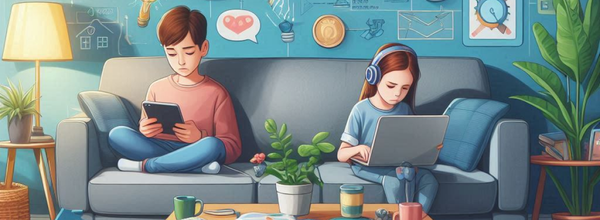Creating a Screen Time Routine That Works: A Parent’s Guide
By setting clear expectations, scheduling screen-free times, and encouraging active screen use, parents can help their children develop healthier digital habits.

Screen time has become a central part of daily life for children and teens, whether it’s for entertainment, schoolwork, or socializing. While technology offers many benefits, finding a healthy balance between screen time and other activities can be challenging for parents. Striking that balance is especially important during the school year and holidays when routines can shift, and screen time can easily spiral out of control.
Creating a screen time routine that works for your family helps ensure that your child’s time online is productive and healthy, while also allowing space for other important activities like exercise, family time, and rest. Here are some practical tips for setting effective screen time limits during both the school year and holiday breaks.
Why a Screen Time Routine Matters
Without clear boundaries, screen time can easily dominate a child’s day. Too much time spent on screens can lead to a range of issues, including poor sleep, difficulty concentrating, and a lack of physical activity. Developing a structured routine around screen time ensures that technology is used in a balanced way, allowing kids to engage in other enriching activities.
A routine can also help foster independence, teaching your child how to manage their time effectively and develop a healthy relationship with technology.
Tips for Setting Effective Screen Time Limits
1. Set Clear Expectations
Start by discussing screen time with your child, explaining why it’s important to have limits in place. Create a family agreement outlining the rules for screen use, including when and where devices can be used. Setting clear expectations helps children understand what is acceptable and encourages them to follow the rules.
For example, you might decide that screens are only allowed after homework and chores are completed, or that devices should not be used during meals or in the bedroom.
2. Schedule Screen-Free Times
Designating certain times of day as “screen-free” can help your child develop healthy habits. This could include setting aside time in the morning, during meals, or an hour before bedtime to be completely free from screens. These breaks not only give children time to rest their eyes but also encourage them to engage in other activities, such as reading, playing outside, or spending time with family.
For younger children, you might use a timer or visual chart to help them see when their screen time is up and when it’s time to transition to other activities.
3. Create a Daily Routine
Develop a daily schedule that balances screen time with other activities. During the school year, this might include designated periods for homework, outdoor play, family activities, and screen use. A structured schedule helps prevent screens from taking over and provides a clear routine for children to follow.
During holidays or weekends, you can relax the schedule but still maintain a routine that includes limits on screen time. For example, you might allow more screen time during holiday breaks but still require screen-free family time in the evenings.
4. Encourage Active Screen Time
Not all screen time is created equal. Encourage your child to engage in active screen time, where they are learning, creating, or engaging in educational content. This could include watching documentaries, participating in online learning programs, or creating videos or digital art.
At the same time, limit passive screen time—such as endless scrolling on social media or binge-watching TV shows—that offers little value.
5. Set a Good Example
Children often model their behavior on what they see from adults. By setting a good example with your own screen time, you can encourage healthier habits in your child. Make an effort to limit your own device use during family time, meals, and other important moments, showing your child that screens don’t always have to be the center of attention.
Adapting Screen Time Limits for Different Ages
The screen time needs of a six-year-old will differ from those of a teenager. For younger children, stricter limits on screen time are usually necessary to ensure they get enough physical play and face-to-face interactions.
For older children and teens, it’s important to balance screen time with schoolwork, socializing, and extracurricular activities. Providing more autonomy for older teens while still maintaining healthy boundaries can help them develop responsible digital habits.
How Spy99 Can Help Manage Screen Time
Spy99 is a parental control app designed to help parents monitor and manage their child’s screen time effectively. With features like screen time limits, real-time monitoring, and daily reports, Spy 99 enables you to track your child’s device use and set appropriate boundaries. By helping you create a screen time routine, Spy 99 ensures that your child’s time online is both balanced and productive.
Establishing a screen time routine is key to helping your child maintain a healthy balance between their digital and offline lives. With tools like Spy99, managing screen time becomes simpler, ensuring that technology remains a positive part of your child’s life without taking over.



